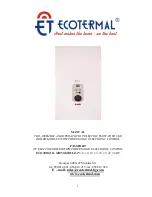
LAARS HEATING SYSTEMS
Page 10
Figure 7. By-pass Piping.
Figure 8. Field Wiring Connections.
Note: On JV sizes 160 and 225 a primary/
secondary piping system is recommended. In this
system, a circulator is dedicated to pumping the boiler
only. This circulator should be sized for the boiler
head loss and flow rate.
The two above piping configurations can also
apply to JV sizes 50, 75 and 100, especially in multi-
zone installations, but flow rates may be obtained
without a by-pass.
All precautions must be taken by the installer to
insure that a maximum temperature rise through the
boiler does not exceed 30°F (-1°C). The temperature
rise on boilers installed in multi-zone systems using
zone valves must be taken when the zone of the
longest length and/or the zone of the highest head loss
is open.
Please note that a 1¼" diameter by-pass with
balancing ball valve must be installed if a return water
temperature of below 110°F (43°C) is expected under
operating conditions (see Figure 7).
1J. Chilled Water Systems
If the boiler is installed in conjunction with
refrigeration systems, it shall be installed so that the
chilled medium is piped in parallel with the heating
boiler with appropriate valves to prevent the chilled
medium from entering the heating boiler.
When boiler piping is connected to heating
coils, which are in close proximity to refrigerated air
circulation, there must be flow control valves or other
automatic methods to prevent gravity circulation of
the boiler water during the cooling cycle.
1K. Electrical Wiring
Follow these instructions to make the necessary
initial electrical connections.
1.
Remove the two screws attaching the front cover
of the control box.
2.
There are four wires coiled in the area on the
right side of the control box, supplied with wire
nuts: 2 black wires twisted together, a white wire
and a brown wire (see Figure 8).
3.
Follow the schematics in Figure 9. Remove the
wire nut from the two black wires, and connect
the hot lead from a 115V power supply to both
wires. Secure the three wires with the wire nut.
The white, neutral wire should be joined to the
other neutral lead coming from the 115V power
supply, and the neutral lead coming from the
pump. The brown wire attaches to the hot side of
the pump.
4.
Attach the leads from the wall thermostat to the
R and W terminals on the terminal strip, located
on the left side of the control box.
5.
When using a Laars or field supplied power
venter, the proving switch must be connected in
series with the hi-limit. See wiring diagrams,
Document 1077. See Figure 1 for vent damper
connections.
6.
Check the boiler wiring and pump for correct
voltage, frequency and phase. If the pump circuit
is other than 115V, be sure there is an
appropriate transformer or relay installed. The
pump relay is suitable for pumps of ¾ HP or
less.
7.
For systems with multiple zone pumps or valves,
see Figure 10.
Transformer BLK
BLK - Hot
WHT - Neutral
WHT - Neutral
BRN - Hot
On = Call
for heat
Power
Supply
115V AC
60 Hz
To Pump
115V AC
3/4 H.P.
Max
BRN
WHT
Pump Relay
115V Field Wiring
115V Factory Wiring
Balancing
Ball Valves
To
System
From
System
In
(Return)
Out
(Supply)
Drip
Leg
Left Side View
A full size by-pass must be installed.










































